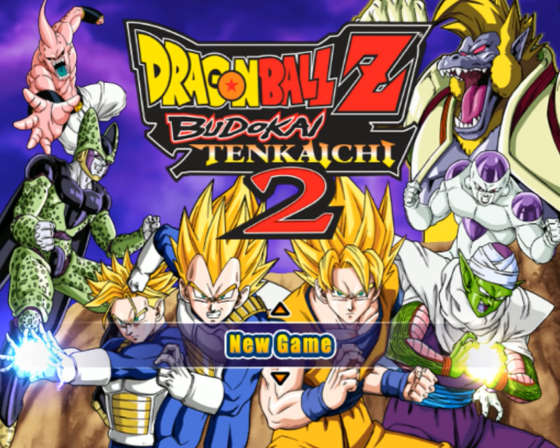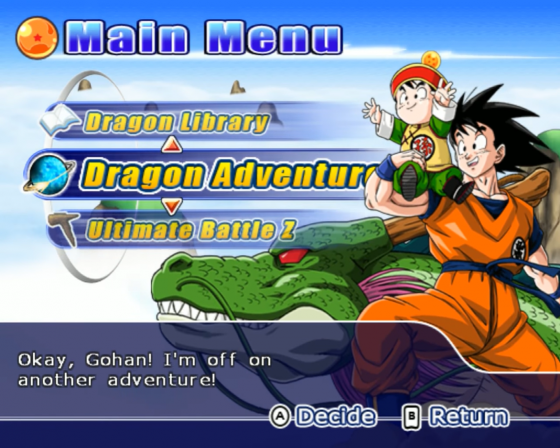
Gaming Age
 13th January 2024
13th January 2024
Author: Travis Dwyer
Publisher: Atarisoft
Machine: PlayStation 2 (US Version)
Dragon Ball Z: Budokai Tenkaichi 2
Atari certainly has taken the Dragon Ball franchise and run with it. They've retold the story of Goku and his friends and foes numerous times through fighting and adventure games. The Budokai series itself is up to five, giving Virtua Fighter and Tekken a run for their money in the longevity department. This is the sequel to Tenkaichi, a fighting game that stepped away traditional mechanics and camera angles. Tenkaichi 2 expands the roster of characters to an insane 120 but does little else to invigorate the mediocre and repetitive gameplay.
Like the first Tenkaichi, the sequel keeps the Budokai name but doesn't resemble the original three, more traditional, games in the least. Although labeled as a fighting game, the structure is more like Bushido Blade. Combat takes place from an over the shoulder third person perspective. The goal, and one the most successful and pleasing aspects about the game, is to recreate the fights from the anime in a faithful style. Dragon Ball Z has always been more about power levels, super energy attacks, and knocking people through mountains than it was about regular punches and kicks in a closed arena. While the game mechanics take some getting used to, the end result is strikingly similar to what one might see in an episode of DBZ.
It may sound like a contradiction, but while the controls and techniques in this game are complex, the actual fighting is rather shallow. Attacking at first appears relegated to one button, which controls your punches and kicks. Another attack button is used to throw ki blasts from a distance but also ends up mixing in some other attacks in the middle of combos. There's a launcher for each character, similar to Marvel vs. Capcom, that sets up air combos, but unlike Capcom's Versus series, there little variety in combos both on the ground or in the air. There's a number of other game "basics" such as Dragon Dash and teleporting that can take you an hour alone to cover in the game's tutorial.

Despite all that's at your disposal, there's very little that is used on a regular basis to get through the game. I guess my biggest beef is how similar every character is to one another. Everyone has nearly the same base combos, just with different animations, and everyone has the same inputs for their special moves. Honestly, I don't want to sound like I'm too down on the fighting system. It's not on the top of my list of technical and engaging fighters, but what it's set out to do, it's done very well. As a casual fan of the show, Tenkaichi 2 is a stunning representation of the anime fight scenes. Matched with the lengthy story mode, it is rather hard to put down.
The aforementioned story mode is the meat of the game, and unlike most fighting games' story mode, this is far more than just an afterthought. In Dead or Alive, or Tekken, you get a couple of mixed in between stages and maybe a short movie at the end. All in all, a typical "story" mode will last you about 1-2 hours. A complete story in DBZ Budokai Tenkaichi 2 will take you through the many DBZ sagas and can last upwards of 20 hours. This is the mode that will unlock characters, transformations, and powers. Unfortunately, for as long as the story mode will take you, the story telling could be better. That and it becomes incredible tedious due to the feeling of sameness from character to character.
The PS2 and Wii versions are nearly identical. One can hardly tell the graphical difference between the two. What you get with the Wii is an alternate control scheme, and a crappy one at that. This is the perfect example of trying to shoehorn a game into the Wii controller instead of building a game from the ground up with the controller in mind. It's far from intuitive. In fact, by having to do things like flick up on the remote to follow up a launcher instead of press a button, it makes it far less easy to use than a standard controller. Some fans may get a kick out of mimicking the kame-hame-ha arm motion with the remote and nunchuck, but personally I find it more of a joke. Forget about acting out the motions of all the unique specials in the game. They've all been boiled down to a few waves and wiggles, and they are far from reliable when compared to a simple button press. In a wise move, the developers have programmed in support for the classic and Gamecube controller.
I'm pretty sure as long as Atari keeps putting Dragon Ball Z on the label, they're going to have a hit on their hands. That's not to say that there isn't and haven't been some decent games to play behind the label. Tenkaichi 2 has really upped the stakes when it comes to playable characters. Now if only each of them had some meat behind their appearance. As it stands, you really only need to play each character once to check out their special moves, say "cool", and move on. Great license, great production values, and a mediocre fighter, that pretty much sums it up.
Other PlayStation 2 Game Reviews By Travis Dwyer
Scores
PlayStation 2 Version| Overall | 58% |
Scores
Nintendo Wii Version| Overall | 58% |













